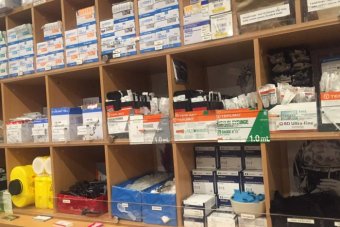Public health experts are warning Australia is in the midst of a Hepatitis C epidemic with almost a quarter of a million people suffering from the blood-borne virus.
Around 90 per cent of new infections are among people who inject drugs and research shows the prevalence of Hepatitis C among those using needle exchange programs is rising despite increased access to clean syringes.
Hepatitis C is the most prevalent blood-borne virus in Australia and because of a lack of symptoms, it can go undetected for years.
If left untreated, the infectious disease attacks the liver and can lead to cirrhosis, end-stage liver disease and liver cancer.
Fiona has been volunteering at the peer-based New South Wales Users and Aids Association (NUAA) needle exchange clinic in Sydney for years.
She contracted Hepatitis C in the mid 1980s while sharing syringes.
“I’m 50 now. I’ve been using for many years, probably over 30,” she said.
“So there was that intense guilt around that, it’s alright for me to get it but it’s not OK for me to give it, and I knew nothing, I didn’t know if I was going to live or die.”
The NUAA needle exchange service is the only peer-based service in the state that allows clients to come in, take what they need and get advice from other drug users.
Fiona said while Hepatitis C education and access to syringes had improved, many people were still sharing, some due to the stigma involved in getting clean gear.
“For some people sharing is part of their routine of drug use, it might be with their partner,” she said.
“It’s also very hard for some people if you are asked to give someone a syringe and you’ve used it and if they are begging you to use that what do you do?
“You don’t want them to be sick or hang out because you understand that feeling, but you don’t want to give them a virus.
“If someone is begging you for that syringe it’s really hard not to.
“It puts you in a real ethical dilemma I suppose.”
Multi-coloured syringes handed out
Today is World Hepatitis Day and among T-shirts and pens reminding clients of the risks of Hepatitis C, Fiona is unpacking a box of multi-coloured syringes, specially designed to stop users from sharing when injecting in a group.
Fellow volunteer James is tallying up the number of syringes he has given out today.
“I just feel like I’m making a difference and yeah if it wasn’t for people doing this, we’d be back in the dark old days which weren’t good,” he said.
“A lot of people got Hep C and when they haven’t got drugs they drink … I’ve seen friends of mine die.”
James, who has also contracted Hepatitis C, said he was now educated on how to prevent the virus.
“As an injecting drug user am I concerned? Not anymore, because it’s all clean if you do the right thing and follow the rules which are quite straight, you can’t go wrong,” he said.
The problem public health authorities are facing is that many people are not following those rules.
Research on people accessing needle and syringe programs in Australia has shown there has been a significant increase in Hepatitis C prevalence among clients in 2014.
A parliamentary inquiry into the virus has heard it is estimated 10,000 people a year contract Hepatitis C and 700 people a year die from Hepatitis C-associated liver disease.
Australian Injecting and Illicit Drug Users League (AIVL) executive officer Annie Madden said a large part of the problem was the stigma and discrimination faced by those trying to access clean equipment.
“People must be able to get access to the amounts and types of injecting equipment they need, when they need it,” she said.
I get pain in my right hand side where I know it’s about my liver, having issues with my kidneys where it’s related to my liver so physically tiredness, depression and those kind of things.
Fiona, drug user and volunteer at New South Wales Users and Aids Association
“That means, as a minimum, providing more access points, after-hours access, increased peer education and removing legal barriers to peer distribution of injecting equipment,” she said.
Candice was also a client at the clinic before starting to volunteer at the service.
“I first contracted Hepatitis C at 19. I’d been using for a year and a half by then and I had a partner I introduced to needle administration as well,” she said.
“We would share with each other and he one day went off and without my knowledge went and shared with people and contracted Hep C.”
Candice said she only found out her partner was positive when he went to jail and was tested for the virus.
While newer and more effective treatments are becoming more widely available they are still expensive and many people are afraid of the side effects.
Many of those who have been living with the virus for decades have watched friends suffer and die and chronic hepatitis infection is now the leading reason for liver transplantation in Australia.
Fiona said the impacts of the virus on her body were only just becoming more obvious now she was getting older.
She is waiting for newer generation Hepatitis C drugs to become available on the PBS.
“I get pain in my right hand side where I know it’s about my liver, having issues with my kidneys where it’s related to my liver so physically tiredness, depression and those kind of things,” she said.
“Heaps of people I know and work with, or are part of my social network, have Hep C and too many have died of liver-related cancer and the like and it’s always really sad and horrible.”
Anyone wanting more information can contact Hepatitis Australia on 1300 437 222.


